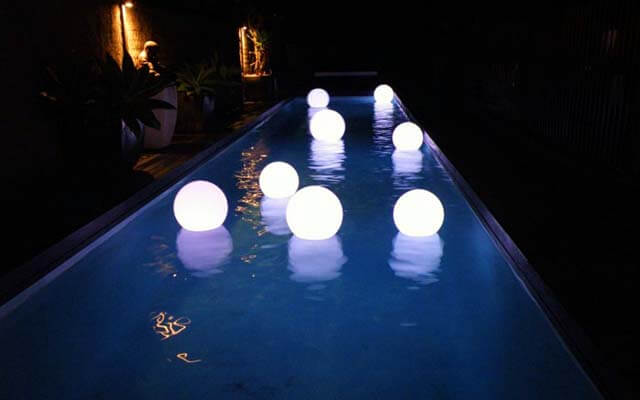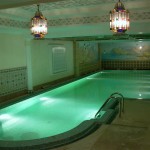What should be the illumination of the pool - 15 photo ideas
Primary requirements
Since electricity and water are incompatible, installing fixtures in a pool has several important limitations related to safety and comfort when bathing.
So, when creating a pool light, you must consider the following requirements:
- Fixtures must work on safe voltage (12 V). It is strictly forbidden to use products powered by a 220-Volt network.
- The degree of protection of all underwater flashlights should be as high as possible, namely IP 68.
- The wiring inside the bowl must be properly sealed. A problem area is a place wire connections between the luminaire and the lead wires, so pay particular attention to this place.
- Lighting devices should be quickly accessible.
- Lamps should not create glare and “sunbeams” on the water surface. At the same time, lighting should not blind a person.
- The illumination of the stairs in the pool should be convenient, and most importantly - safe for descent.
- Light should “flood” the entire area of the bowl, including the bottom.
Lighting options
Today, there are two main types of backlight: underwater and general.
General illumination is installed outside and is used for the upper illumination of the water surface and the territory adjacent to the pool. In this case, it is recommended to install searchlights and lamps on brackets, the design of which allows you to create a directional light flux. It would also be a good idea to install wall lights if there is any garden building near the pool in the country.
There are no special requirements for the protective properties of the products, because in this case, contact with water will be completely absent.
For underwater pool lighting installation of spotlightslocated on the bottom and side walls of the bowl.
Its main purpose is to emphasize the shape of the object, as well as give it an unusual design look. In this case, it is recommended to place the products around the perimeter of the pool at an equal distance from each other. If this recommendation is not followed, the backlight will be uneven and the appearance of the bowl will only worsen. An alternative to spotlights is the LED strip. LED lighting is becoming very popular and it is also very easy to attach the tape to the walls of the bowl.
Another modern lighting option that I would like to talk about is the installation of floating lights.Such an intermediate arrangement of objects (on the surface of the water) cannot be attributed to more than one of the above options. In this case, spherical waterproof flashlights are used, which can move freely and illuminate the entire water surface. Their main purpose is a decorative function. Most often, pool lighting with floating lights is used in inflatable and frame tanks, because here it is more problematic to mount LEDs or tape.
Costly but interesting pool lighting can be done using fiber optic cable. With the help of this lamp, it is easy to design the architectural illumination of the bowl, which will be original and constantly changing. The only rule to consider when installing the optical fiber is that the power supply must be placed away from water so that the wiring does not short circuit.
To illuminate the indoor pool, which may be in the house or cottage, it is recommended to use LED ceiling lights. Also in the room you can make the original illumination of the bowl with an LED strip.
Light bulb selection
After you decide on the lighting fixtures, you must correctly select the lamps for lighting the pool. In total there are 2 options: halogen and LED lamps. Halogens have a brighter luminous flux and the radius of its dispersion. At the same time, the disadvantage of such light sources is a shorter service life.
As for LED lamps, they can work much longer, while saving up to 70% of electricity. The disadvantage is a smaller lighting radius and high cost of products.
I would like to note that LED lamp unlike halogen ones, they can have several color glow options. When installing special RGB lights, the pool bowl can be painted in all the colors of the rainbow to your taste.
We also draw your attention to the fact that the above listed bulbs were considered as underwater lights. For general, you can use any of the existing options.
Useful Tips
Finally, we bring to your attention several useful tips for creating lighting in the pool with your own hands:
- When buying underwater lights, pay attention to their technical characteristics. The main indicator is the maximum installation depth, which should meet your conditions. If the product will be placed deeper than recommended in the standards, then there is the option that it will quickly fail.
- It is not necessary to install underwater flashlights directly at the bottom. In this case, in the event of a breakdown, it will be necessary to completely drain the water to access the product. You can simplify your life by placing lamps on the walls of the pool directly above the water. In this case, the entire tank will be lit, and at the same time, nothing will be under water.
- Usedimmers and filters, so that you can change the intensity and color of the light.
- To create the original soft lighting of the pool, use floating lamps with a matte shade.
- Protect yourself by installing waterproof luminaires over the bowl. Despite the fact that they will not have contact with water, accidental splashing or condensation may cause short circuit.
We also recommend watching a video that provides an inexpensive option for highlighting:
Photo examples
Well, the last thing I wanted to provide in this article was a photo of the modern illumination of the pools:
Also read:


























